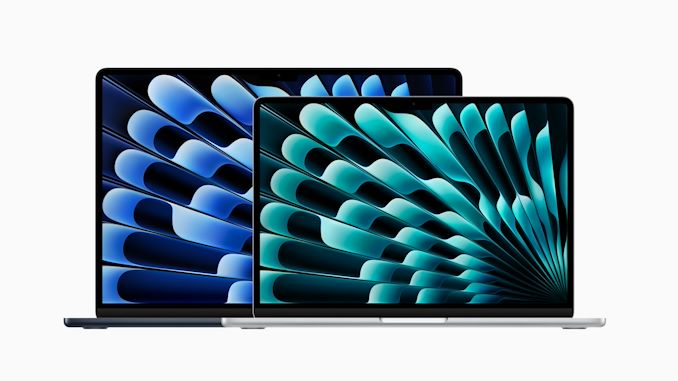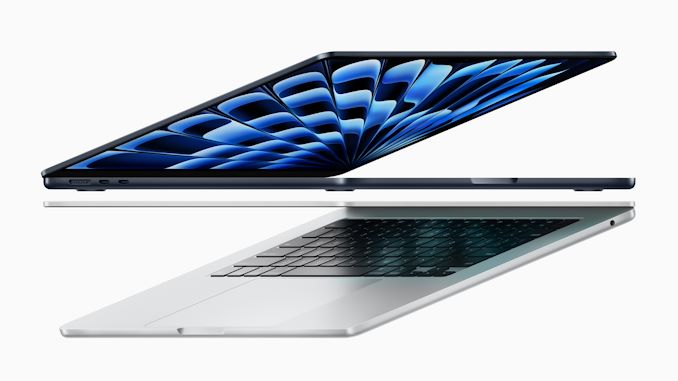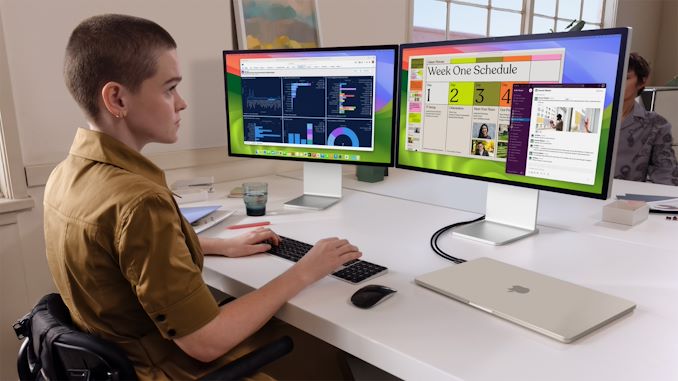Apple Launches M3-Based MacBook Air 13 and 15: 3nm CPU for the Masses
by Anton Shilov on March 4, 2024 7:00 PM EST
Apple on Monday introduced its new generation MacBook Air laptops based on the company's most-recent M3 system-on-chip (SoC). The new MacBook Air notebooks come in the same sizes as the previous models – 13.6 inches and 15.3 inches – with prices starting from $1,099 and $1,299 respectively.
The key improvement in Apple's 2024 MacBook Air laptops is of course the M3 processor. Fabbed on TSMC's N3B process, Apple's latest mainstream SoC was first launched late last year as part of the 2023 MacBook Pro lineup, and is now being brought down to the MacBook Air family. The vanilla M3 features four high-performance cores operating at up to 4.05 GHz, four energy-efficient cores, a 10 core GPU based on the latest graphics architecture (with dynamic caching, hardware-accelerated ray tracing, and hardware-accelerated mesh shading), and a new media engine with hardware-accelerated AV1 decoding.
| MacBook Air Specifications | ||||||||
| Model | MBA 15 2024 |
MBA 13 2024 |
MBA 15 2023 |
MBA 13 2022 |
MBA 13 2020 |
|||
| CPU | Apple M3 4C/4T High-Perf + 4C/4T High-Eff |
Apple M2 4C/4T High-Perf + 4C/4T High-Eff |
Apple M1 4C/4T High-Perf + 4C/4T High-Eff |
|||||
| GPU | Apple M3 Integrated (8 or 10 Cores) |
Apple M2 Integrated (8 or 10 Cores) |
Apple M1 Integrated (7 or 8 Cores) |
|||||
| Memory | 8 - 24 GB LPDDR5-6400 | 8 - 24 GB LPDDR5-6400 | 8 - 16 GB LPDDR4X-4266 | |||||
| SSD | 256 GB - 2 TB | 256 GB - 2 TB | 256 GB - 2 TB | |||||
| I/O | 2x USB4 Type-C w/Thunderbolt 3 1x MagSafe 3 3.5mm Audio Touch ID |
2x USB4 Type-C w/Thunderbolt 3 1x MagSafe 3 3.5mm Audio Touch ID |
2x USB4 Type-C w/Thunderbolt 3 3.5mm Audio Touch ID |
|||||
| Display | 15.3-inch 2880x1864 IPS LCD P3 with True Tone |
13.6-inch 2560x1664 IPS LCD P3 with True Tone |
15.3-inch 2880x1864 IPS LCD P3 with True Tone |
13.6-inch 2560x1664 IPS LCD P3 with True Tone |
13.3-inch 2560x1600 IPS LCD P3 with True Tone |
|||
| Dimensions | Width | 34.0 cm | 30.4 cm | 34.0 cm | 30.4 cm | 30.4 cm | ||
| Depth | 23.7 cm | 21.5 cm | 23.7 cm | 21.5 cm | 21.2 cm | |||
| Height | 1.1 cm | 1.1 cm | 1.1 cm | 1.1 cm | 0.41 - 1.61 cm | |||
| Weight | 3.3 lbs (1.5 kg) | 2.7 lbs (1.22 kg) | 3.3 lbs (1.5 kg) | 2.7 lbs (1.22 kg) | 2.8 lbs (1.29 kg) | |||
| Battery Capacity | 66.5 Wh | 52.6 Wh | 66.5 Wh | 52.6 Wh | 49.9 Wh | |||
| Battery Life | 15 - 18 Hours | 15 - 18 Hours | 15 - 18 Hours | |||||
| Price | $1299 | $1099 | $1299 | $1199 | $999 | |||
Like prior vanilla M-series SoC, the M3 offers two display engines, allowing it to drive up to two displays. Normally this has been one internal and one external display, but new to the M3/2024 MBAs, the laptop can also drive two external 5K displays when the internal display is disabled (e.g. the lid's closed).
With regards to performance, Apple is opting to compare the new AIrs to the 2020 models with Apple's M1 SoC. The CPU is said to be up to 35% – 60% faster compared to the original M1 chip depending on the workload, but such comparisons should be taken with a grain of salt as companies tend to overhype their biggest advantages. One thing to keep in mind is that since MacBook Airs come without active cooling, their performance is typically lower than MacBook Pros running the same processor.
The SoC supports up to 24 GB of LPDDR5-6400 memory (featuring bandwidth of 100 GB/s), though entry-level MacBook Air models still feature only a diminutive 8 GB of RAM and a 256 GB SSD. More advanced (and usable) configurations offer 16 GB or 24 GB of memory and up to 2 TB of solid-state storage.
Other improvements of Apple's 2024 MacBook Air laptops based on the M3 processor compared to predecessors include Wi-Fi 6E support; improved three-microphones array with enhanced voice clarity, voice isolation, and wide spectrum modes.
As for input/output capabilities, the new MacBook Air notebooks feature two Thunderbolt 4/USB-C ports, a MagSafe port for charging, a 3.5-mm jack for headsets, and a 1080p FaceTime HD camera.
The 2024 Apple MacBook Air come in midnight, starlight, silver, and space gray colors. The machines are equipped with a 52.6 Wh battery that provides up to 18 hours of video playback. The 13.6-inch machine is 0.44 inch (1.13 cm) thick and weighs 2.7 pounds (1.24 kilograms), whereas the 15.3-inch laptop is 0.45 inch (1.15 cm) thick and weighs 3.3 pounds (1.51 kilograms).
With the launch of its M3-based MacBook Airs, Apple will discontinue its M2-based MacBook Air 15, but will retain the M2-based MacBook Air 13 as their entry-level option, with prices now starting at $999.
Source: Apple













48 Comments
View All Comments
bji - Tuesday, March 5, 2024 - link
The spec jockeys will never understand. You are wasting your time trying to explain it to them. Replymeacupla - Monday, March 4, 2024 - link
It is until you use any kind of video editing software, which is where M series excels at. It will constantly crash when it runs out of RAM.The 8gb/256gb model is part of the pricing strategy.
I think it's called "Decoy Pricing", and it's to entice customers to buy the next step up. Reply
lemurbutton - Monday, March 4, 2024 - link
If you're a Youtuber starting out, 8GB of RAM is actually fine on an M3 machine. Just get an external SSD to store your files. ReplySamus - Wednesday, March 6, 2024 - link
8GB RAM is not actually fine on any modern OSX machine and Apple knows it - the MSRP is pure marketing and while it will be the highest volume model by sales, it won't be anything like entry-level iPhones (where the base model accounts for 90% of sales.) This is simply a money grab to milk more out of buyers. No matter what OS you run, a webkit browser like Safari or Chrome will use 4GB RAM across 30 tabs (the average for users these days) even with memory management idling stale tabs. Thinking you will edit 4K video on 8GB RAM is a joke - that isn't even enough memory to cache 60 seconds of raw video you are applying lives filters. In other words the experience will be laggy as shit regardless of your SSD performance. Replyname99 - Wednesday, March 6, 2024 - link
Why do you imagine that EVERY mac users will(a) edit video (something I have never done in my life)
(b) run 30 tabs – something I do but many non-tech friends do NOT do.
How many times do you have to be told that THESE MACHINES ARE NOT FOR YOU!!!
If you want to bitch, in a very boring way that interests no-one, about the cost of the 15" MBP with 24GB DRAM and 1TB SSD that is right for you, go ahead.
But don't pretend that what you want is exactly the same as EVERY OTHER PERSON ON EARTH. Reply
Samus - Wednesday, March 6, 2024 - link
As an AT reader you can't possible be so disconnected from the reality of average users: the vast majority of people never close tabs. I regularly see iPhones, iPads and Mac's with hundreds of tabs open.Defending Apple putting 8GB RAM in a non-upgradable PC in 2024 is unfathomable. If anything, average users need MORE RAM because they are less efficient. These are the people with 50GB+ mailboxes, stale tabs, multiple programs left open and 500 files on the desktop. Reply
Oxford Guy - Thursday, March 14, 2024 - link
Apple does it again and again.1) Apple II. No lowercase letters. For the price Apple was charging that was ridiculous. I have read that so many of its school deals were settled at strip clubs, which can help to explain why such low-performance high-priced machines found their way into public schools.
2) Apple III. Overheated and the clock didn't work. Buyers told to drop it onto a desk to try to re-seat the RAM.
3) Apple IIGS. Massively overpriced for its paltry amount of RAM and low CPU clock rate.
4) Lisa. OS programmed mostly in Pascal so it ran like a slug. Floppy drives didn't actually work. Cheesy 5 MHz 68000 instead of a faster one. No graphics acceleration. Scrolling through a word processing document was horrendously slow.
5) Mac 128K. No hard disk support. Braindead file system. Absurdly small monitor considering the price tag. Designed so that the entire machine had to be replaced rather than the RAM be upgradable, even though Jobs conned the tech press by unveiling the 'first new Mac' which had 512K.
6) Mac XL. Apple decided to enrich humanity by burying these in landfills even though they were selling briskly. Why? Because Apple is beneficial for humanity. To further insult people, the company dropped OS support practically immediately.
7) Mac Portable. Lead acid is completely inappropriate battery technology for a laptop because its chemistry requires that it never be discharged, even more than a small amount. Plus, Apple's geniuses didn't give it a backlight and made it insanely expensive by using SRAM as main memory.
8) The Mac LC. 32-bit processor placed onto a 16-bit bus simply to prevent it from performing "too well.' Starved of RAM upgradability.
9) Mac Classic. 8 MHz 68000 that was cutting edge in 1980.
10) Mac TV. No more than 8 MB of RAM at time of release made zero sense to anyone, even people easily conned.
11) Performa 5000 series. 68K leftover parts used with a PPC CPU; trashed performance and reliability. Sold with too-little RAM to be usable on the Internet. Modem, which was too slow on its own, ran at a slug's pace because of the trash-tier design.
12) Mac OS X 1.x. Jobs sold this to the public as an incredibly advanced operating system mainly intended for high-end work, for $500. Didn't even support Firewire!
13) iMacs that were designed with no fan (later models, not the bulb-shaped ones). This caused them to eat their hard drives. A university I know that had them had a nearly 100% failure rate over time. Opening the case caused, much of the time, the wifi antenna or the webcam to break. I don't remember which.
14) Modern Macbook Pros, such as the 1 TB 2013 model with 16 GB of RAM. Perfectly usable but forced into the junk pile merely because Apple refuses to let them run current security patches. Yes, folks, these machines have double the RAM and quadruple the SSD storage of new Macs. They're obsolete, though, because Apple says so.
and on and on Reply
GeoffreyA - Sunday, March 17, 2024 - link
10/10. Excellent post. It made me chuckle. ReplyOxford Guy - Thursday, March 14, 2024 - link
I forgot to mention some of the other 'greatest hits' with the Apple III, too. Poor backward compatibility. Too-high price. 8-bit machine with not even the most advanced 8-bit CPU released when it was = not competitive. ReplyOxford Guy - Thursday, March 14, 2024 - link
I also forgot to mention the glorious episode which was Apple's refusal to replace the graphics in 2008 or so Macbook Pros that had defective Nvidia GPUs (all of these GPUs were defective). Instead, the company would either install used ones (which were of the same defective design) or new ones (which were of the same defective design).That a large corporation could get away with that speaks volumes about the state of corporate capture. Reply